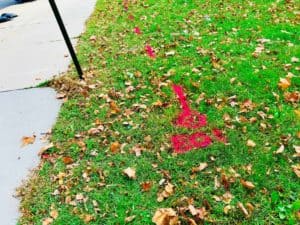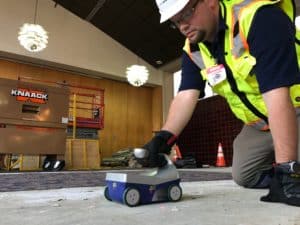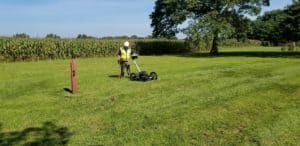There are many types of utility locating equipment available in the market these days. Utility Locator, LLC utilizes both electromagnetic and ground penetrating radar equipment to successfully locate most underground utilities on your project or construction sites. Although advancements in technologies have made the equipment much more reliable recently, the theories and principles behind how the equipment works has widely remained unchanged for decades.
Electromagnetic Utility Locating Equipment
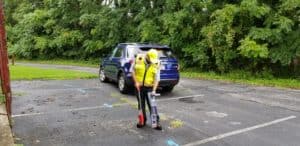 Electromagnetic locating equipment is the primary equipment we use to identify the location of underground utilities. It works by transmitting an electromagnetic frequency through the conductive material of an underground utility. For water pipes, we would apply the signal directly to the pipe by connecting to the pipe at a riser, hydrant, or valve. When applying a signal to a cable system such as electric or telephone, we will typically connect to the grounding structure of the utility. We can locate power lines by connecting to a meter box, transformer, or ground wire. Telephone and Cable TV systems can be located by applying a signal to the ground cables within a pedestal, manhole, or interface box.
Electromagnetic locating equipment is the primary equipment we use to identify the location of underground utilities. It works by transmitting an electromagnetic frequency through the conductive material of an underground utility. For water pipes, we would apply the signal directly to the pipe by connecting to the pipe at a riser, hydrant, or valve. When applying a signal to a cable system such as electric or telephone, we will typically connect to the grounding structure of the utility. We can locate power lines by connecting to a meter box, transformer, or ground wire. Telephone and Cable TV systems can be located by applying a signal to the ground cables within a pedestal, manhole, or interface box.
Locate Underground Utilities with a Direct Connection.
The key to a successful utility locate is to Locate Underground Utilities with a Direct Connection. When we apply a known and controlled signal to a utility, this is known as active locating. Active utility locating allows us to attempt to isolate the target utility from other utilities. This is not always possible 100% of the time, however, active locating is the preferred and most reliable utility locating method.
Once the signal has been applied to the target utility using a transmitter, the technician can detect the signal transmission on the surface using a receiving device. The receiver will typically be the second part of the equipment set, however, many receivers can be custom programmed to detect additional frequencies that are not native to the manufacture. We like to think of this like customizing the wheels on your car. You can choose to use wheels that are OEM (original Equipment Manufacture), or you can purchase after market parts. Either way you slice the pie, your vehicle has wheels.
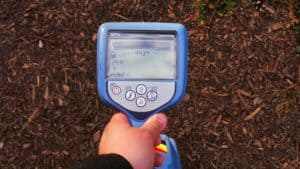 The opposite of active locating isn’t called inactive locating as one would assume, but rather it is referred to as passive locating. Locating a utility with the passive method is the act of trying to identify the location of an underground utility by detecting the natural radio transmissions or frequencies from that utility. These frequencies can often be unreliable and misleading, which is why active locating is always preferred. Many different utilities can produce the same passive signals, making it difficult for a utility locator to distinguish the difference between them.
The opposite of active locating isn’t called inactive locating as one would assume, but rather it is referred to as passive locating. Locating a utility with the passive method is the act of trying to identify the location of an underground utility by detecting the natural radio transmissions or frequencies from that utility. These frequencies can often be unreliable and misleading, which is why active locating is always preferred. Many different utilities can produce the same passive signals, making it difficult for a utility locator to distinguish the difference between them.
In the USA, electric cables will commonly produce a 60Hz (50Hz overseas) electromagnetic frequency that can be detected using passive locating methods. All too often, private utility locators will use this as a “short cut” to designate the location underground power lines as it is often easier and quicker than connecting to the utility with an active connection. unfortunately, there are many other utilities that will produce similar or identical frequencies, which may lead to mis-marks and missed utility lines. Water, natural gas, steam, cable tv, and copper telephone cables are just a few of the other utilities that can produce this passive frequency. Without an active connection to the target utility, a utility locate technician could easily mark the wrong utility, leaving the target utility unmarked entirely.
Even through passive signals can create confusion with ordinary locator technicians, we are able to use the vast array of utilities that transmit this signal to our advantage. Utility Locator, LLC will utilize passive locating methods to clear a site only after all of the known utilities have been located using the more reliable active method. We will perform grid patterns throughout the work site to determine the location of any additional utilities that may be present. This can help us to identify other utilities that may not have had any surface features to connect to within or around the project site. In addition, passive locating ma also help in identifying the location of abandoned utilities and underground structures such as underground storage tanks (USTs).
The Split-Box Locator
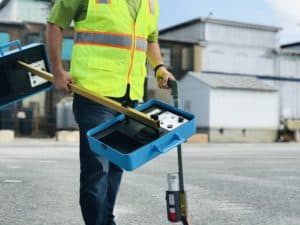 Another popular piece of electromagnetic equipment we rely on to ensure 100% quality is called the split-box locator. There are a few different manufactures, however, the most common are Aquatronics and Fisher. The device works by inducing, or broadcasting an electromagnetic radio frequency into the ground with a transmitter device attached to the back end of a pole. Once the frequency is transmitted through a buried metallic object, such as a pipe, cable, or other object, the receiver unit located on the other end of the pole will produce a reading. This is particularly helpful when clearing a construction site for all underground utilities. This device does not require an active connection, but like passive frequencies, it may not be clear to the technician what utility they are locating, only that they are locating a metallic object buried underground.
Another popular piece of electromagnetic equipment we rely on to ensure 100% quality is called the split-box locator. There are a few different manufactures, however, the most common are Aquatronics and Fisher. The device works by inducing, or broadcasting an electromagnetic radio frequency into the ground with a transmitter device attached to the back end of a pole. Once the frequency is transmitted through a buried metallic object, such as a pipe, cable, or other object, the receiver unit located on the other end of the pole will produce a reading. This is particularly helpful when clearing a construction site for all underground utilities. This device does not require an active connection, but like passive frequencies, it may not be clear to the technician what utility they are locating, only that they are locating a metallic object buried underground.
The Keyword Here is Metallic
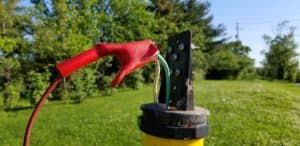 As powerful as these electromagnetic devices are for locating underground utilities, they all rely on one key component: conductivity. The target utility must be capable of transmitting or conducting a signal. Electromagnetic frequencies behave in the same pattern as AC Electrical current. The frequency will follow the path of least resistance, and must be conductive. The use of tracer wire on plastic systems such as Natural Gas and Chilled Water are one way to locate non-conductive or plastic underground utilities. We can also introduce a conductor to a system to locate it, such as inserting a traceable duct rodder or metal fish tape into a storm or sanitary sewer system.
As powerful as these electromagnetic devices are for locating underground utilities, they all rely on one key component: conductivity. The target utility must be capable of transmitting or conducting a signal. Electromagnetic frequencies behave in the same pattern as AC Electrical current. The frequency will follow the path of least resistance, and must be conductive. The use of tracer wire on plastic systems such as Natural Gas and Chilled Water are one way to locate non-conductive or plastic underground utilities. We can also introduce a conductor to a system to locate it, such as inserting a traceable duct rodder or metal fish tape into a storm or sanitary sewer system.





